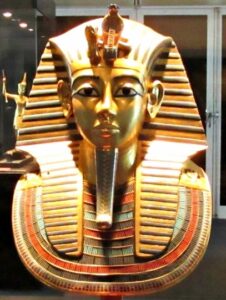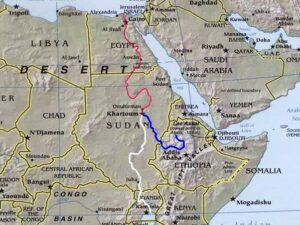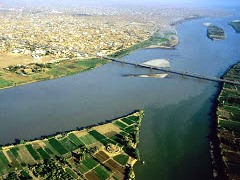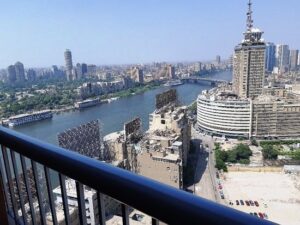» posted on Thursday, August 11th, 2022 by Linda Lou Burton
But Who’s Counting?
Originally published August 7, 2020 by Linda Lou Burton posting about Cairo, Egypt from Little Rock, Arkansas – There are 81 cities in the world with a population over 5 million. Only 9 of those are in the US. I’ve been to them, and I’ve been to 6 of the ones outside the US. But I’ve never been to a city as large as Cairo. About 20,790,000 people live in the metro area, give or take a few. And over 9 million of those live downtown. Am I daunted by that? A little.
 The negatives were considered when I plotted out my time here. Air pollution is serious. There are 4.5 million cars on Cairo streets, most of them old. And there are many unregistered lead and copper smelters in Cairo, major polluters. Because of the lack of rain, plus the city’s layout of tall buildings and narrow streets, which create a bowl effect, the dispersion factor is poor. A permanent haze over the city with particulate matter three times normal causes serious respiratory diseases and eye irritations; it is estimated that between 10 to 25 thousand deaths related to air pollution occur in a year; tourists need to take extra care. Another caution: Cairo is considered one of the most dangerous cities in the world for women; 99% of women living here report they have been sexually harassed, though new national laws define and criminalize those behaviors.
The negatives were considered when I plotted out my time here. Air pollution is serious. There are 4.5 million cars on Cairo streets, most of them old. And there are many unregistered lead and copper smelters in Cairo, major polluters. Because of the lack of rain, plus the city’s layout of tall buildings and narrow streets, which create a bowl effect, the dispersion factor is poor. A permanent haze over the city with particulate matter three times normal causes serious respiratory diseases and eye irritations; it is estimated that between 10 to 25 thousand deaths related to air pollution occur in a year; tourists need to take extra care. Another caution: Cairo is considered one of the most dangerous cities in the world for women; 99% of women living here report they have been sexually harassed, though new national laws define and criminalize those behaviors.
 Still, I am here, and I always focus on the positives. On the plus side of things, this city is bubbling over with history. Founded in 969, it’s pretty young when you consider that just 9 miles to the west sits the Sphinx, which some Egyptologists believe is at least 4,500 years old. And then there’s all that King Tut stuff here in Cairo museums, remnants of ancient civilizations. But I didn’t come for that. I came for two specific reasons: to see the Great Pyramid of Giza, one of the constructed Wonders of the World. And I came because of the River Nile. Of course, Cairo does happen to be a capital city as well! And I am counting.
Still, I am here, and I always focus on the positives. On the plus side of things, this city is bubbling over with history. Founded in 969, it’s pretty young when you consider that just 9 miles to the west sits the Sphinx, which some Egyptologists believe is at least 4,500 years old. And then there’s all that King Tut stuff here in Cairo museums, remnants of ancient civilizations. But I didn’t come for that. I came for two specific reasons: to see the Great Pyramid of Giza, one of the constructed Wonders of the World. And I came because of the River Nile. Of course, Cairo does happen to be a capital city as well! And I am counting.
Cairo sits mostly on the east bank of the Nile, and almost at the end of the river’s 4,160-mile journey from south of the equator to the Mediterranean Sea. Yes, it flows northward, and its  basin includes parts of Tanzania, Burundi, Rwanda, the Democratic Republic of the Congo, Kenya, Uganda, Ethiopia, Sudan, and the cultivated part of Egypt. I’ll go with what most geographers say about its beginnings; the Blue Nile comes from Lake Tana in Ethiopia and the White Nile from Lake Victoria in Tanzania; they converge at Khartoum in the Sudan
basin includes parts of Tanzania, Burundi, Rwanda, the Democratic Republic of the Congo, Kenya, Uganda, Ethiopia, Sudan, and the cultivated part of Egypt. I’ll go with what most geographers say about its beginnings; the Blue Nile comes from Lake Tana in Ethiopia and the White Nile from Lake Victoria in Tanzania; they converge at Khartoum in the Sudan  where the waterway becomes the “Nile,” which in ancient Egyptian means “great river.” It winds and twists its way into Egypt where it meets the Aswan Dam, built in the 1960s; an embankment dam that has produced both positive and negative benefits, as any effort to control nature generally does. Massive amounts of electricity, increasing water resources, and flood control – good; decrease in the fertility of agricultural lands in the delta – bad. Those floods deposited millions of tons of silt each year, nature’s way of fertilizing without chemicals. The building of the dam also impacted the ancient cities and temples along the river; controversy there.
where the waterway becomes the “Nile,” which in ancient Egyptian means “great river.” It winds and twists its way into Egypt where it meets the Aswan Dam, built in the 1960s; an embankment dam that has produced both positive and negative benefits, as any effort to control nature generally does. Massive amounts of electricity, increasing water resources, and flood control – good; decrease in the fertility of agricultural lands in the delta – bad. Those floods deposited millions of tons of silt each year, nature’s way of fertilizing without chemicals. The building of the dam also impacted the ancient cities and temples along the river; controversy there.
So how could I get myself on this river? There are many cruises available; most are south of Cairo, on luxury boats with stops allowing “visits to ancient civilizations” while carefully  avoiding the Nile crocodile. A 12-day Viking cruise beginning and ending in Cairo sounded enticing. Let your imagination soar as your ship meanders through panoramic desertscapes, fertile farmlands, colorful villages and UNESCO World Heritage Sites that preserve the ancient glory of Egypt’s greatest temples, palaces and tombs. Included excursions in every port reveal highlights like these:
avoiding the Nile crocodile. A 12-day Viking cruise beginning and ending in Cairo sounded enticing. Let your imagination soar as your ship meanders through panoramic desertscapes, fertile farmlands, colorful villages and UNESCO World Heritage Sites that preserve the ancient glory of Egypt’s greatest temples, palaces and tombs. Included excursions in every port reveal highlights like these:
- Luxor’s Karnak Temple complex
- The Necropolis of Thebes, Egypt’s largest repository of pharaonic tombs
- Luxor Temple, with its sphinx-lined avenue
- Privileged Access to the tomb of Nefertari in the Valley of the Queens
- The graceful temple of Hatshepsut, Egypt’s only female pharaoh
- The temple of Hathor at Dendera
- The romantic, waterbound Temple of Isis at Philae
- Horse-drawn calèche tour to Edfu’s Temple of Horus
I didn’t have time for all of that! I just wanted to cruise the Nile.
 So I settled for an evening dinner cruise in Cairo with pickup from my hotel. Itinerary, their translation: Sun Pyramids Tours will pick you up from your hotel and transfer to Nile Pharaoh Dinner Cruise dock. Embark the famous Cairiane cruises which resembles a pharaonich barge with tribute to ancient Egyptian god Hathor. From the deck you can take panoramic views of Cairo skyline at the evening. Enjoy a sumptuous international buffet dinner with variety of Egyptian and international cuisine and desserts. Live performances of belly dance, and tanura the sufi meditation whirling dervish shows will take place while you are having dinner. After dinner you can again rise to the deck to enjoy the air breeze of the Nile and take in the marvelous glittering sights of Cairo as the boat returns back to the dock. Upon arrival you will be transferred back to your hotel.
So I settled for an evening dinner cruise in Cairo with pickup from my hotel. Itinerary, their translation: Sun Pyramids Tours will pick you up from your hotel and transfer to Nile Pharaoh Dinner Cruise dock. Embark the famous Cairiane cruises which resembles a pharaonich barge with tribute to ancient Egyptian god Hathor. From the deck you can take panoramic views of Cairo skyline at the evening. Enjoy a sumptuous international buffet dinner with variety of Egyptian and international cuisine and desserts. Live performances of belly dance, and tanura the sufi meditation whirling dervish shows will take place while you are having dinner. After dinner you can again rise to the deck to enjoy the air breeze of the Nile and take in the marvelous glittering sights of Cairo as the boat returns back to the dock. Upon arrival you will be transferred back to your hotel.
 I expect my head will be whirling like that dervish by the time I get to bed. But my room does overlook the Nile; and my view stretches far across this busy whirling city that has 4.5 million horn-honking cars. There may be too much pollution and too much commotion, but tomorrow I have an entire day to hang out with the Sphinx and touch the Pyramid of Giza. And I will have cruised the Nile, just think how much of Africa its waters have touched!
I expect my head will be whirling like that dervish by the time I get to bed. But my room does overlook the Nile; and my view stretches far across this busy whirling city that has 4.5 million horn-honking cars. There may be too much pollution and too much commotion, but tomorrow I have an entire day to hang out with the Sphinx and touch the Pyramid of Giza. And I will have cruised the Nile, just think how much of Africa its waters have touched!
Pluses, and minuses, but who’s counting?
